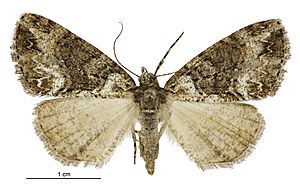Common forest looper facts for kids
Quick facts for kids Common forest looper |
|
|---|---|
 |
|
| Male | |
 |
|
| Female | |
| Scientific classification | |
| Kingdom: | |
| Phylum: | |
| Class: | |
| Order: | |
| Family: | |
| Genus: | |
| Species: |
P. suavis
|
| Binomial name | |
| Pseudocoremia suavis Butler, 1879
|
|
The common forest looper (scientific name: Pseudocoremia suavis) is a type of moth. It belongs to the Geometridae family, which are sometimes called 'looper moths'. This moth is usually found only in New Zealand. But in 2007, some were found in Cornwall, Great Britain. This was the first time they had been seen outside of New Zealand!
Contents
Where They Live
The common forest looper is very common all over New Zealand. It eats many different kinds of trees and shrubs there.
In 2007, a moth that looked like this one was caught in a garden in west Cornwall, Great Britain. This garden was next to a small plant nursery. Scientists think the moth might have traveled to Britain on plants from another nursery. It took a year for experts at the Natural History Museum, London to confirm it was the common forest looper.
Life Cycle of the Moth
Scientists have studied the life cycle of the common forest looper. Here's what they found:
Eggs
A female moth can lay many eggs, sometimes over one hundred! She lays them one by one or in small groups. When the eggs are first laid, they are dark green. After about seven days, they turn brownish-purple. The tiny caterpillars hatch from the eggs after about seventeen days. They even eat their own egg cases!
Larvae (Caterpillars)
The larvae, or caterpillars, of the common forest looper eat many different types of trees and shrubs. Sometimes, they can cause a lot of damage to forests. For example, in the 1950s and 1960s, they caused serious damage to Monterey pine forests in Canterbury, New Zealand. In the 1970s, they also damaged Douglas fir trees on the North Island of New Zealand.
Pupae
After the caterpillar stage, the moth enters the pupa stage. The pupae are about 10–12 mm long. They are green at first, but turn a shiny brown color in about two days. This stage usually lasts for two to three days.
Adult Moths
When the moth is fully grown, it has a wingspan of about 30 mm. This is about the length of a standard paperclip.
What They Eat
The caterpillars of the common forest looper eat a wide variety of plants in New Zealand. These include southern beech trees, podocarps, and kanuka (Kunzea ericoides). They also eat European gorse (Ulex europaeus).
In Cornwall, some caterpillars first ate Leyland cypress trees. Later, they were moved to Scots pine trees. They also ate box (Buxus sempervirens) and yew (Taxus baccata) plants, but they seemed to like Scots pine the best.

